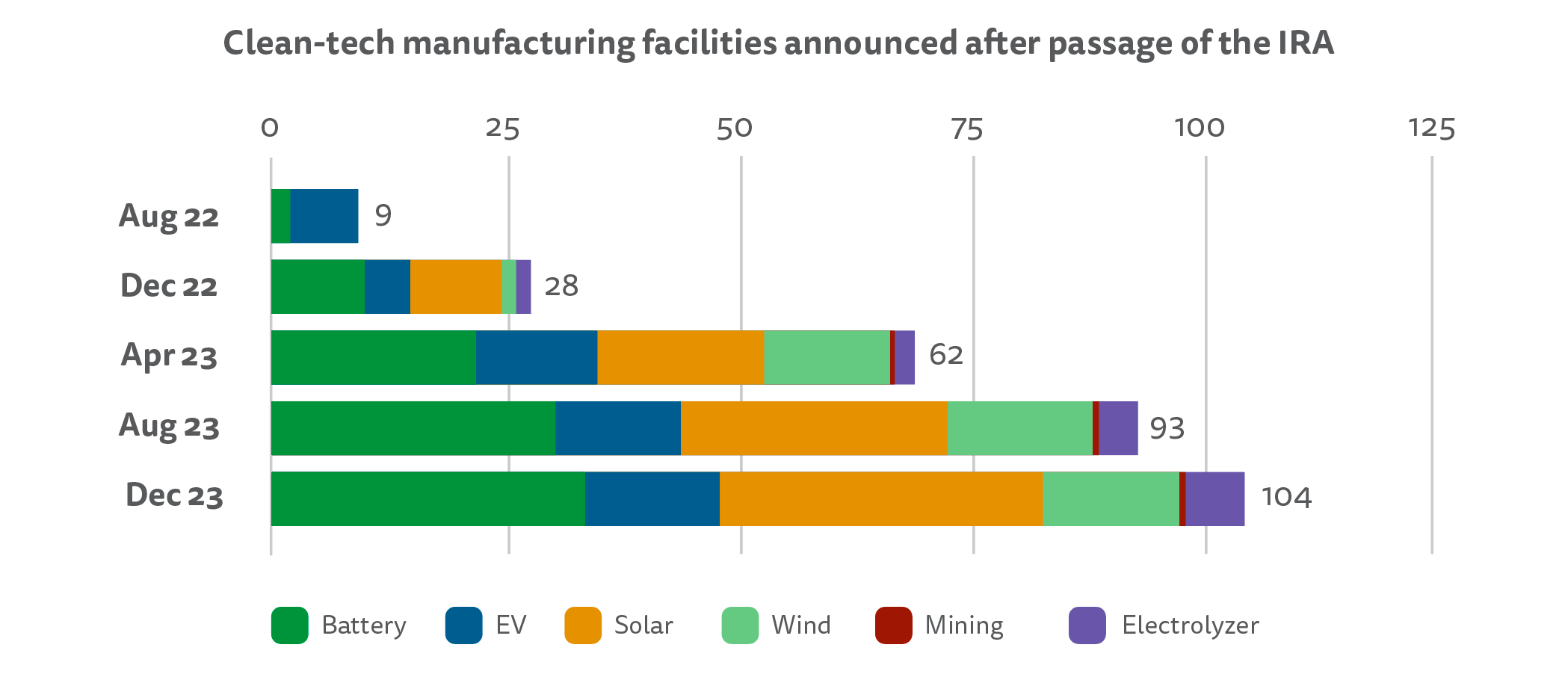By Lizzie Stricklin, Communications Manager, BCSE
In 2023, U.S. clean energy sectors proved resilient, as both mature and emerging decarbonization industries grew despite interest rate and supply chain difficulties. A suite of federal policies boosted the clean energy transition, providing clear signals to the market that resulted in record levels of investment and deployment.
That’s the key takeaway from the 2024 Sustainable Energy in America Factbook. Produced annually by the Business Council for Sustainable Energy and BloombergNEF, the Factbook tracks energy market and policy trends in the United States, examining how clean energy sectors performed in 2023 and over the past decade.
Here are some of the top clean energy trends from 2023:

1. Strong federal policies support the growth of clean energy industries, attracting record-levels of investment and increasing America’s competitiveness.
With the clean energy transition already hard-wired into the U.S. economy, investments surged in the first full year after the passage of the Inflation Reduction Act (IRA) in August 2022. In 2023, the United States saw market growth in more mature clean energy technologies as well as emerging decarbonization solutions.
Plans for 104 manufacturing facilities were announced, representing $123 billion in investments. These included 34 new battery and 34 new solar facilities.
Electric vehicle sales surged 50 percent to nearly 1.46 million vehicles sold. In addition, 42 gigawatts of new renewable power-generating capacity were added to the U.S. grid.
A record-shattering $303 billion in energy transition financing was deployed in the United States, and global levels soared to $1.7 trillion. The IRA also awakened investments in emerging sectors, including hydrogen, carbon capture and storage, renewable natural gas, and sustainable aviation fuel, which all saw notable growth in 2023.

2. The BCSE portfolio of clean energy solutions provides the majority of U.S. electricity.
In 2023, BCSE’s diversified energy portfolio of energy efficiency, natural gas, and renewable energy demonstrated their role as the foundation of the U.S. energy transition. Natural gas and renewable energy together met 66 percent of electricity demand in 2023, up from 41 percent a decade ago.
Coal’s contribution to power generation slid to 16 percent in 2023 – its lowest ever – and was largely replaced by natural gas. This current portfolio of low- and zero-carbon resources is not only reducing power sector emissions but is also offering the flexibility needed to reliably manage the electricity grid.

3. U.S. energy productivity increased by 3.8 percent in 2023.
The clean energy transition is bolstered by ongoing investments in energy efficiency. Energy productivity – a measure of economic output per unit of energy consumed in the United States – is an essential metric to grade our country’s competitiveness in the global market. In 2023, the U.S.’ energy productivity grew by 3.8 percent, as the economy expanded by 2.4 percent and primary energy consumption slowed by 1.4 percent.
U.S. energy productivity has grown 30.6 percent over the past decade and has improved by an astounding 101 percent since 1990. This shows that the long-term trend of the United States using energy more efficiently is making the U.S. more competitive.

4. U.S. greenhouse gas emissions dropped in 2023, but the U.S. saw the most extreme weather events on record.
The United States experienced 28 extreme weather events, the highest number ever recorded, causing nearly $93 billion in damages in 2023. The U.S. energy system is critical infrastructure that needs immediate attention to avoid the negative consequences of extreme weather and natural disasters. Resiliency is a key concern of communities and consumers – as evidenced by the roughly 2.8 gigawatts of microgrids that have been brought online since 2012.
In 2023, U.S. emissions declined for the first time since 2020, falling 1.8 percent to a level comparable to 1987. Emissions fell across all sectors except for transport. In fact, 2023 emissions were 16 percent below 2005 levels. However, the pace of reductions is not where it needs to be – 50 to 52 percent reductions are needed to meet the U.S. goal under the Paris Agreement.
The 2024 Sustainable Energy in America Factbook is free to download at bcse.org/factbook. Dive deeper into the facts by checking out the Executive Summary, Key Trends, and additional Clean Energy Industry Resources.
About the author: Lizzie Stricklin is the communications manager for BCSE.

